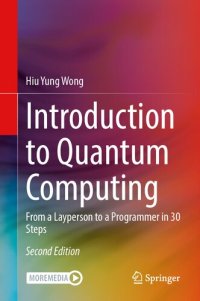
Ebook: Introduction to Quantum Computing: From a Layperson to a Programmer in 30 Steps, 2nd Edition
Author: Hiu Yung Wong
- Genre: Computers // Software: Systems: scientific computing
- Year: 2023
- Publisher: Springer
- Edition: 2
- Language: English
- pdf
Quantum computing sounds fancy but also scary. Is it possible to learn quantum computing rigorously without years of training in mathematics, physics, and Computer Science? This book tries to address this question. For any serious learner who has some basic training in science or engineering at the junior level, they should find this textbook useful to prepare themselves to start a serious quantum computing journey within a few months.
This book is based on an introduction to quantum computing class I teach at San Jose State University. The target audiences are senior and master’s students who do not have a strong background in linear algebra and physics. This book is suitable for self-study or as a textbook for a one-semester or one-quarter introduction class at senior or master’s level. After spending 60–90 hours of reading, students are expected to be able to understand the critical concepts of quantum computing, construct and run quantum computing circuits, and interpret the results. For self-study students, it is recommended to read the book and do the exercise for 3–4 hours per week for about 20 weeks (about 1–2 chapters per week).
There are two parts in this book. Part I teaches linear algebra with an emphasis on quantum computing applications. Part II teaches quantum computing gates and algorithms. If the readers have not been exposed to quantum computing and do not have a very strong background in linear algebra, it is recommended to read from the first chapter to the final chapter in sequence. Part I is “entangled” with Part II. Many important quantum computing concepts are introduced in Part I. It is not recommended to start with Part II even if the readers already have some background in linear algebra. Part I of this book can also be used to enhance the students’ understanding of linear algebra as standalone teaching material.
Real quantum computers (IBM-Q) are used to implement some of the algorithms, and students are encouraged to write their own simple simulator using Google Co-lab.
This book is based on an introduction to quantum computing class I teach at San Jose State University. The target audiences are senior and master’s students who do not have a strong background in linear algebra and physics. This book is suitable for self-study or as a textbook for a one-semester or one-quarter introduction class at senior or master’s level. After spending 60–90 hours of reading, students are expected to be able to understand the critical concepts of quantum computing, construct and run quantum computing circuits, and interpret the results. For self-study students, it is recommended to read the book and do the exercise for 3–4 hours per week for about 20 weeks (about 1–2 chapters per week).
There are two parts in this book. Part I teaches linear algebra with an emphasis on quantum computing applications. Part II teaches quantum computing gates and algorithms. If the readers have not been exposed to quantum computing and do not have a very strong background in linear algebra, it is recommended to read from the first chapter to the final chapter in sequence. Part I is “entangled” with Part II. Many important quantum computing concepts are introduced in Part I. It is not recommended to start with Part II even if the readers already have some background in linear algebra. Part I of this book can also be used to enhance the students’ understanding of linear algebra as standalone teaching material.
Real quantum computers (IBM-Q) are used to implement some of the algorithms, and students are encouraged to write their own simple simulator using Google Co-lab.
Download the book Introduction to Quantum Computing: From a Layperson to a Programmer in 30 Steps, 2nd Edition for free or read online
Continue reading on any device:

Last viewed books
Related books
{related-news}
Comments (0)